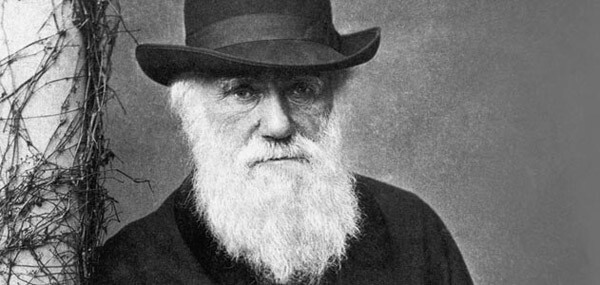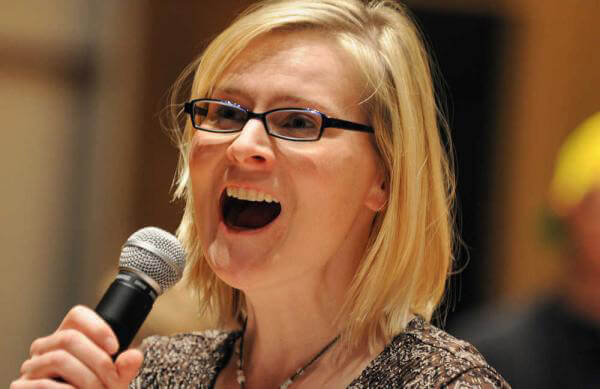 As a fitting finale for its 20th anniversary season, newEar Contemporary Chamber Ensemble departed from its usual recital format and even its usual venue to mount the world premiere of Darwin, a full- length chamber opera in three acts based on the life and writings of Charles Darwin. Joining the venerable instrumental ensemble was a fine cast of singer/actors: tenor (and newEar pianist) Robert Pherigo as Darwin, child soprano Audrey Hartwell as young Annie Darwin, tenor Jedd Schneider as Captain Robert FitzRoy, baritone Paul Griggsby as biologist Thomas Henry Huxley, and soprano Sylvia Stoner in several roles, most notably as the Worm Queen. Also featured were dancers from The Owen/Cox Dance Group, choreographed by co-artisitic director Jennifer Owen. The City Stage Theatre at Kansas City’s historic and beautifully restored Union Station was the setting for the opera’s performances on April 26-27, 2013.
As a fitting finale for its 20th anniversary season, newEar Contemporary Chamber Ensemble departed from its usual recital format and even its usual venue to mount the world premiere of Darwin, a full- length chamber opera in three acts based on the life and writings of Charles Darwin. Joining the venerable instrumental ensemble was a fine cast of singer/actors: tenor (and newEar pianist) Robert Pherigo as Darwin, child soprano Audrey Hartwell as young Annie Darwin, tenor Jedd Schneider as Captain Robert FitzRoy, baritone Paul Griggsby as biologist Thomas Henry Huxley, and soprano Sylvia Stoner in several roles, most notably as the Worm Queen. Also featured were dancers from The Owen/Cox Dance Group, choreographed by co-artisitic director Jennifer Owen. The City Stage Theatre at Kansas City’s historic and beautifully restored Union Station was the setting for the opera’s performances on April 26-27, 2013.

Naturalist Charles Darwin (image credit: Bettmann / Corbis)
Darwin was composed in 2012 by Michael Henry in collaboration with Dwight Frizzell. A workshop version was produced in 2009, but newEar commissioned this definitive, expanded version. The two men have been long time collaborators in the avant-garde music scene in Kansas City since the early 80’s. Many, myself included, fondly remember Henry’s and Frizzel’s band BCR frequently opening for the innovative rock/folk/polka band Brave Combo, a most fascinating combination.
Comprising the whole first half of the evening, Act I retraces Darwin’s journeys around South America aboard the H.M.S. Beagle. We witness Darwin’s initiation into The Court of Neptune during the equator crossing accompanied by rowdy sailors and lusty sea songs, “What Should we do With a Drunken Sailor” being prominently featured. The dancers were brilliant portraying the strange rituals and often universally familiar habits of the indigenous Yaghan people of Tierra del Fuego. Darwin remarked how similar they were to other people despite eons of isolation. The act ends with Darwin on Galapagos making his first articulations of his germinal theory. Pherigo was in fine voice, if a bit hard to understand at times, in Darwin’s climactic aria on the theory of natural selection.
For the second and third acts, the ensemble and singers retreated to the background, functioning as incidental music to a spoken play. That worked well, frankly, since the monologs were taken directly from Darwin’s writing and brought the audience a deep understanding Darwin’s work. One could hear and even see, through Pherigo’s polished portrayal of the increasingly ill Darwin, how he, with almost child like wonder, pieced together his opus On The Origin of Species. Set in London after Darwin’s return from his HMS Beagle voyage, Darwin’s friends, detractors, and even Jenny the Orangutang interact simultaneously via acting and dancing in a stream-of-conscious summation of Darwin’s later years.

Soprano Sylvia Stoner (photo credit: cjonline.com)
In the final act, played without pause, we see Darwin, accompanied by the dance troupe quite imaginatively costumed as worms, working on his last book, a once quite popular study of earthworms. A final aria sung by Stoner as the Worm Queen brings the opera and Darwin’s life to a most appropriate close as the worms consume the now deceased Darwin as he lays in his grave.
The true stars of the performance were the talented dancers of the Owens/Cox Dance Group who were called upon, as noted, to portray everything from primitive people, monkeys, and elegant London society mavens, to earthworms. The ten piece newEar instrumental ensemble (minus a few regular newEar members who were likely performing Gilbert and Sullivan down the street at the Lyric Opera) negotiated the eclectic score with ease, moving from Greensleeves and other folk melodies, to deftly accompanying almost Mozartian arias, to producing evocative and elemental earth sounds.
The sets and lighting were minimalist yet totally effective, allowing visual projections to set the scenes and moods. Henry and Frizzell’s multi-channel, spatial sound mix began the opera as the audience was seated. Wide ranging, windy and bleak, it quickly set the stage for a sea voyage of discovery and wonder.
Henry and Frizzell wisely avoided any preaching about the validity of evolution. Instead, through the evocative music, vibrant dance, engaging visuals, and a most satisfying performance, they told the story of a very human man who just happened to change the way we look at our world and our very existence.






















